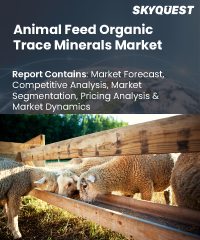
Report ID: SQMIG30B2022

Report ID:
SQMIG30B2022 |
Region:
Global |
Published Date: April, 2024
Pages:
198
|
Tables:
95 |
Figures:
75
Animal Feed Organic Trace Minerals Market size was valued at USD 548.98 Million in 2023 and is poised to grow from USD 590.76 Million in 2024 to USD 1062.26 Million by 2032, growing at a CAGR of 7.61% during the forecast period (2025-2032).
Animal Feed Organic Trace Minerals are becoming popular since It is Bound to organic molecules such as amino acids or peptides and is more easily absorbed and used by animals than inorganic minerals. The various advantages of organic trace minerals include improved animal performance, enhanced immune function, reduced environmental impact, improved carcass quality, increased profitability, reduced mineral interactions and increased safety.
Organic trace minerals have proven to be advantageous in promoting better animal performance. They have been found to enhance the growth rate of animals, leading to higher productivity and increased profitability for farmers. Additionally, organic trace minerals improve feed efficiency, meaning that animals can utilize their feed more effectively and convert it into energy rather than wasting it. This results in a reduced amount of feed required to sustain the animals, leading to cost savings for farmers. Furthermore, organic trace minerals can improve the reproductive performance of animals, including fertility and reproductive longevity. This can be particularly beneficial for breeding programs and help ensure a consistent supply of high-quality livestock. Along with this, the use of organic trace minerals in animal feed can also have a positive impact on the environment. Because organic trace minerals are more easily absorbed and utilized by animals, they are excreted in smaller quantities than inorganic ones. This reduces the number of excess minerals excreted by animals, which can have negative environmental effects, such as soil and water pollution. By reducing the number of excess minerals excreted, organic trace minerals can help to maintain the balance of nutrients in soil and water, preserving the health of ecosystems. This is particularly important in regions where intensive livestock production is practiced, as accumulating excess minerals can be a significant environmental concern.
The inclusion of organic trace minerals in animal feed can also have a positive impact on the quality of the meat produced. Organic trace minerals have been found to enhance meat's tenderness, color, and shelf life. In particular, organic trace minerals such as zinc, copper, and selenium have been shown to play a role in the development of muscle tissue and the maintenance of healthy skin and coat. This can lead to improvements in meat quality, such as improved tenderness and juiciness.
US Animal Feed Organic Trace Minerals Market is poised to grow at a sustainable CAGR for the next forecast year.
Our industry expert will work with you to provide you with customized data in a short amount of time.
REQUEST FREE CUSTOMIZATIONWant to customize this report? This report can be personalized according to your needs. Our analysts and industry experts will work directly with you to understand your requirements and provide you with customized data in a short amount of time. We offer $1000 worth of FREE customization at the time of purchase.

Report ID: SQMIG30B2022